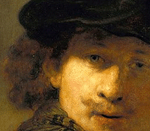
"Christ in the Storm on the Sea of Galilee"
Jan Brueghel (also Bruegel or Breughel) the Elder (1568 – 13 January 1625) was a Flemish painter and draughtsman. He was the younger son of the eminent Flemish Renaissance painter Pieter Bruegel the Elder. A close friend and frequent collaborator with Peter Paul Rubens, the two artists were the leading Flemish painters in the Flemish Baroque painting of the first three decades of the 17th century.
Brueghel worked in many genres including history paintings, flower still lifes, allegorical and mythological scenes, landscapes and seascapes, hunting pieces, village scenes, battle scenes and scenes of hellfire and the underworld. Jan Brueghel the Elder achieved a superb technical mastery, which enabled him to render materials, animals and landscapes with remarkable accuracy and a high degree of finish.
The Catholic Counter-Reformation's worldview played an important role in the artist's practice. Central in this worldview was the belief that the earth and its inhabitants were revelations of a supreme being, God. Artistic representation of, and scientific investigation into, that divine revelation was encouraged and valued.
In this painting, Brueghel places the narrative events in a setting that recalls another sub-genre of landscape painting, that of the marine view. While paying considerable attention to the main motif, he also focuses on the setting, using a high viewpoint and offering a broad panorama of a coastline that effectively combines real with imaginary elements. This is the case with the fortress on an island in the center of the panel that can be related to a drawing of the Castel dell’Ovo now in the Boijmans Van Beuningen Museum, executed by Brueghel during his time in Naples. Brueghel uses a narrow but rich and glowing color range in the present panel, with an emphasis on green, blue and grey tones that contrast with the intense and vibrant reds of the Apostles’ tunics, and the yellows and pinks of other pieces of drapery. The remarkable quality of the minutely detailed brushstroke is evident in all the details that fill this composition, for example the faces of the figures, and the care and delicacy in the depiction of the jagged coastline and the buildings of a large city on a bay evident in the distance.